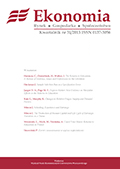Forecasting Turning Points with Composite Leading Indicators - the Case of Poland
K. Zalewski
ABSTRACT: This paper concerns the problem of short-term forecasting of economic activity. With the use of Composite Leading Indicators the business cycles of Polish economy are forecasted for 1992–2007 and confronted with real data. Results of Composite Leading Indicator analysis conducted for the end of 2007 suggest possible downturn phase at the beginning of 2008.
Full text (PDF)
Issue number: 24
In this issue:
Employment Specialization in the Enlarged European Union
A. Parteka
ABSTRACT |
PDF
This paper presents the evolution of absolute employment specialization along the course of economic growth of EU–25 countries. We focus on the degree to which EU economies concentrate labor force in a few sectors/industries. We use disaggregated statistics classified according to NACE Rev. 1 division (71 sectors) and calculate various synthetic indices measuring the degree of diversification typical for the employment structures of EU15 countries (1970–2004) and ten NewMember States (1995–2004). Using nonparametric and semiparametric estimation techniques, we estimate the relationship between employment specialization and the development level, controlling for the inclusion of additional determinants of the diversification process. The main findings are in line with the trends revealed in analogical empirical studies using industrial data for international samples of countries: also within the enlarged EU there is a tendency towards decreasing absolute specialization of employment at initial phases of growth matched with an upward rising trend after over passing the GDP per capita level of about 16000 US $ (const 2000).
Corruption and Social Norms
Ł. Goczek
ABSTRACT |
PDF
The paper investigates the effect of an exogenous social norm of administrative corruption on the incentives to be corrupt for bureaucrats that participate in the non-cooperative principal-agent game. This setting leads to many density dependent effects: i.e., critical population thresholds, which separate equilibriums with low levels of corruption from equilibriums with high levels of corruption. In order to counter the problem of multiple equilibriums evolutionary game theory is employed into the analysis. This means that people are no longer assumed able to be perfectly rational. Rather, they adopt strategies on the basis of trial and error, adapting their behavior on the basis of its 'success' with the result that they gravitate towards the relatively most successful type of behavior. As a result, we characterize the emergence of an equilibrium behavioral pattern within the population of bureaucrats as a social convention arising under the assumption that they tend to imitate relatively more rewarding behaviors.
The Impact of International Trade and Foreign Competition on Labour Earnings in Poland
E. Stępień
ABSTRACT |
PDF
This paper investigates the influence of international trade and increasing foreign competition on earnings in Poland. Using disaggregated income data for skilled labour in the years 1999 and 2004, and OLS and IV estimation methods it examines the impact of liberalisation of international trade and foreign direct investment flows between Poland and the European Union. The conducted analysis suggests that increased competition forces domestic firms to raise the salaries of the best educated workers.
Forecasting Turning Points with Composite Leading Indicators - the Case of Poland
K. Zalewski
ABSTRACT |
PDF
This paper concerns the problem of short-term forecasting of economic activity. With the use of Composite Leading Indicators the business cycles of Polish economy are forecasted for 1992–2007 and confronted with real data. Results of Composite Leading Indicator analysis conducted for the end of 2007 suggest possible downturn phase at the beginning of 2008.
Shadow Economy and Its Relations with Tax System and State Budget in Poland
S. Cichocki
ABSTRACT |
PDF
There are controversies regarding existing estimates of the size of shadow economy in Poland. Therefore this paper focuses on the measurement of shadow economy in Poland over the period 1995–2007. On the basis of monetary methods, an econometric model for currency demand is built. Using estimation results, the size of shadow economy is assessed. According to the estimates shadow economy declined in the period 1995–2007 starting from 40% of GDP in 1995 and reaching about 10% of GDP in 2007. The paper also analyses relations between shadow economy, state budget and tax system. A Vector Autoregressive model is estimated and Impulse Reaction Functions are drown, showing that an increase in indirect tax burden enlarges shadow economy. A contrary effect arises due to an increase in: a) direct tax burden; b) budget balance.
Conditional Tests of Factor Augmented Asset Pricing Models with Human Capital and Housing: Some New Results
O. Klinkowska
ABSTRACT |
PDF
In this paper I develop the asset pricing model in which the wealth portfolio is enriched with human capital and housing capital. These two types of capital account for a significant portion of the total wealth. Additionally I introduce dynamics into the model and represent conditioning information by common factors estimated with dynamic factor methodology. In this way I can use more accurate representative of the unobservable information set of the investors. Obtained results prove that indeed better proxy for market return matters. Moreover conditional models show promising empirical performance and often price the cross-section of excess equity returns better than the Fama French three factor model.
On Importance of Main Economic Categories: Jel Codes Analysis
K. Karbownik, M. Knauff
ABSTRACT |
PDF
This article contributes to an increasing number of papers on economic profession and deals with analysis both the most popular categories for the period 1998–2007 and their dynamics over time. We use data on topics covered by papers published in years 1998–2008 given by codes of Journal of Economics Literature (JEL) classification system. The data are analyzed not only by using descriptive statistics but also by applying tools of frequentist trend. We show that an increase in the number of papers published is connected with an increase in the number of different JEL codes used. Moreover we study the importance of different sub-fields of economics, how it is changing over time. Aggregation of JEL codes may influence observed trends. Using most detailed JEL codes allows to observe some phenomena not visible in case of aggregation.

